Mad Hedge Technology Letter
September 13, 2021
Fiat Lux
Featured Trade:
(THE DATABASE MOST WANTED BY DEVELOPERS 4 YEARS RUNNING)
(MDB), (MSFT), (IBM), (SAP), (ORCL), (CLDR)

Mad Hedge Technology Letter
September 13, 2021
Fiat Lux
Featured Trade:
(THE DATABASE MOST WANTED BY DEVELOPERS 4 YEARS RUNNING)
(MDB), (MSFT), (IBM), (SAP), (ORCL), (CLDR)

MongoDB’s latest earnings’ results validate the concept open source software as a rival to the opposed closed-source software grid.
A keen rival of MongoDB’s RedHat was also acquired by IBM (IBM) a few years ago showing the vitality of the sub-sector.
Don’t sleep on these companies as another one Cloudera (CLDR) were taken private by private equity firms KKR and Clayton, Dubilier & Rice.
These are highly valuable assets and I’m not the only one shouting from the rooftops.
How did this all first start?
The first open-source projects were not really businesses, they were counter attacks against the unfair profits that closed-source software companies were reaping.
Microsoft (MSFT), Oracle (ORCL), SAP (SAP), to name a few, were enforcing monopoly-like “rents” for software that were substandard in quality.
The latest evolution of open source came when developers evolved the projects with two important elements.
The first is that the open-source software is now developed largely within the confines of businesses.
Often, more than 90% of the lines of code in these projects are written by the employees of the company that commercialized the software.
Second, these businesses offer their own software as a cloud service from inception.
In a sense, these are Open Core / Cloud service hybrid businesses that can obtain multiple pathways to monetize their product and that is exactly what MongoDB did.
By offering the products as SaaS, these businesses can interweave open-source software with commercial software so customers no longer have to worry about which license they should be taking.
MongoDB Atlas is a great example of this evolution and can become the dominant business model for software infrastructure.
This is their hottest product which is a fully-managed cloud database and Atlas handles all the complexity of deploying, managing, and healing deployments on the cloud service provider of your choice like Amazon or Google.
MongoDB changed how open-source software is licensed, and they introduced the new cloud service that required them and partners to compete with the largest cloud providers.
Looking quickly at second-quarter financial results, they generated revenue of $199 million, a 44% year-over-year increase and above the high-end of guidance. They grew subscription revenue 44% year over year.
Mongo Atlas revenue grew 83% year over year and now represents 56% of revenue, and they had another strong quarter of customer growth, ending the quarter with over 29,000 customers.
Businesses that can develop software faster are able to ultimately outgrow their competition.
MongoDB’s results are a clear indication that customers view MongoDB as a critical platform to accelerate their digital innovation agenda.
Customers of all types are choosing MongoDB because they can develop so much faster using this platform to build new applications and replatform legacy applications across a broad range of use cases to drive business forward.
Even though MongoDB open-source software is lower cost per unit, it makes up the total market size by leveraging the elasticity in the market. When something is cheaper, more people buy it. That’s why open-source companies have such massive and rapid adoption when they achieve product-market fit.
The model now is that companies are venturing as far as actually open sourcing all their software but applying a commercial license to parts of the software base. The premise being that real enterprise customers would pay whether the software is open or closed, and they are more incentivized to use commercial software if they can actually read the code.
Observing how airline JetBlue deployed MongoDB is how these new approaches and improved products manifest themselves in the topline revenue.
JetBlue came to the decision to overhaul their core e-commerce app, and JetBlue chose the MongoDB application data platform.
MongoDB's flexible data model allowed JetBlue to build a dynamic customer experience with modern ticketing applications, as well as predictive analytics in real-time.
An avalanche of firms is leveraging the tools of MongoDB tools to up their digital game.
Management has steered the narrative to include the ease of use and expanding the capabilities of the MongoDB platform to make it more compelling for customers to standardize on MongoDB.
For example, a serverless, customer can get started with MongoDB without having to pick a specific machine type or size. The application connects to Atlas, and they handle the elastic scaling of compute and storage seamlessly, whether an application scales fast or becomes popular. Customers no longer must do capacity planning or manual intervention to adjust the size of the deployment.
The verdict is in and deploying MongoDB to harness in-house developers to build unique commercial applications has been a winning formula.
Not only are they sheltered from rigid closed-source software, but customers can even integrate the code first, then pay later when it is deployed, and this licensing model has been extremely beneficial for developers who need to test out whether certain code is valuable or not.
Atlas is now the cash cow for MongoDB and forecasts predict acceleration in top-line growth.
Yes, this company is still small procuring revenue of just $166 million in 2018, but 2023 will see annual revenue surpass $1 billion which is why everyone wants to hop on MondoDB’s train.
I would consider any dips to deploy capital in MongoDB, I would call it a rising star of the software world, and a gem in the developers’ world.

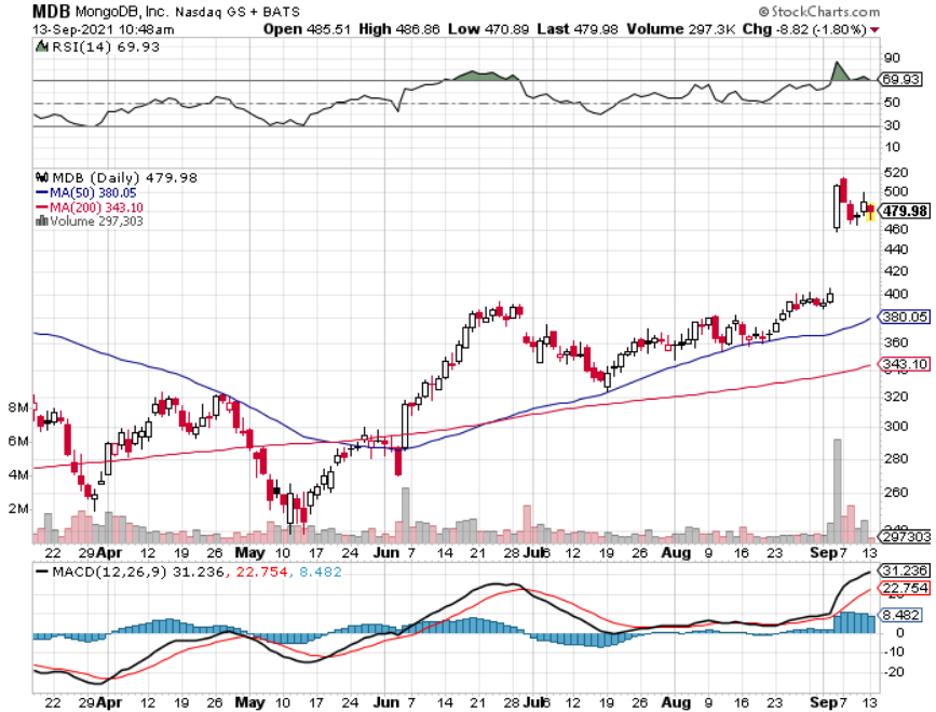
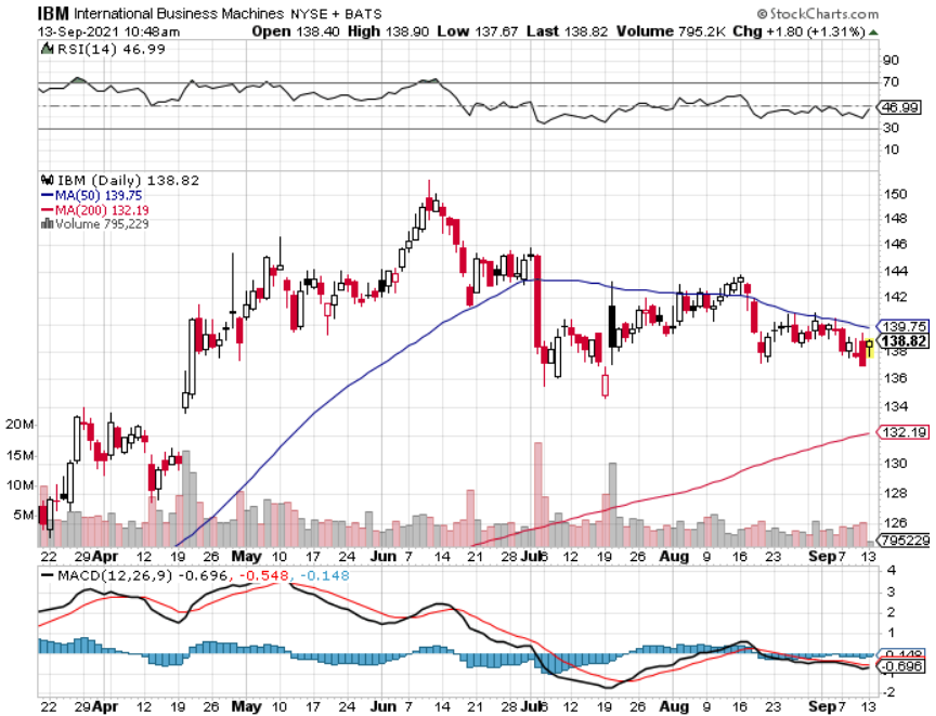
Mad Hedge Technology Letter
December 7, 2020
Fiat Lux
Featured Trade:
(THE OPPORTUNITIES IN BIG DATA)
(SPLK), (WK), (MDB), (ESTC)

It’s all great knowing about the cloud, but to understand the cloud more deeply, and how it affects investment trends, we need to talk about Big Data.
This is epitomized by massive data troves.
That avalanche of data on a daily basis coming from an ever-growing variety of sources is now the genesis of all and any corporate decisions.
Data sets are now decoded by processing software tools that capture, process, and curate in a timely fashion.
Let’s take an ecommerce business, their data creation and gathering process comes from sources that include wholesale or retail transactions.
Other companies look into the shipping, audio and video logs, text messaging, internet search queries, cookies, satellite imagery, and GPS data, as well as stock-market activity and financial transactions. Data is also flooding in from the Internet of Things.
The process of analyzing data sets from numerical evidence is now coined data analytics.
Extracting all manner of data in order to draw out conclusions about the information is the competitive advantage of today. In addition, it uncovers undiscovered themes or unknown correlations within the data, or unearths emerging market trends leading companies to better understand customer preferences.
The data analytics’ industry is growing by leaps and bounds, fueled by market demand for systems that tolerate the intense requirements of Big Data.
Which up and coming, second-tier tech companies have cornered the best data analysts that could boost their stock price over the medium term?
I would include a short list of firms like MongoDB (MDB), Elastic (ESTC), Workiva (WK), and Splunk (SPLK).
Big data companies can focus on various areas, including data mining and cleaning, data analysis, machine data, visualization, and storage.
The trend has also fueled an expansion in new Big Data IPOs include Alteryx (AYX), Cloudera (CLDR), Talend (TLND), and New Relic (NEWR). Splunk was among the first to come public.
Investors who want a data analyst army to drive stock performance should look no further than these companies.
Although they don’t harness the type of intellectual property (IP) of monopolists such as Apple or Google, they add specific functions to the tech industry and are rocket boosters to many business models that already are benefiting from massive secular tailwinds.
Let’s dive into a few data-based firms that I think are worth your time and attention.
MongoDB (MDB)
MongoDB provides an open-source database platform for businesses, with a subscription-based software-as-a-service business model.
MongoDB's iconic flagship application can do pretty much anything in a relational database from Oracle and the difference between relational and NoSQL databases is that the relational model is rigidly defined and difficult to change.
MongoDB's software is more flexible than traditional database models, which allows developers to complete tasks more efficiently.
NoSQL databases are easy sells in today's software development sector, so MongoDB's sales are skyrocketing. The company isn't profitable yet because management has optimized the business model for maximum top-line growth.
The company burns cash but compensates for that with elevated growth rates. MongoDB’s underlying shares are up around 90% YTD.
Splunk (SPLK)
Splunk provides intelligence software designed to aid search, correlate, analyze, monitor, and report on data in real time. The software is deployed to analyze vast amounts of historical information. They specialize in machine-data applications.
Splunk stock took a big hit when the company reported third-quarter results, and the natural consolidation of many big data stocks that have come too far, too fast will offer optimal entry points for tech investors.
Splunk reported lower-than-expected bookings and annual recurring revenue due to a drop in the rate of closing deals, especially large-sized transactions.
Poor revenue forecasts and deal weakness could be a great buying opportunity.
Elastic (ESTC)
Elastic harnesses a set of software products that ingest and store data from various sources and formats, as well as perform search, analysis, and visualization.
The company uses a cloud-based software-as-a-service business model. It has 12,900 subscribers, which accounted for 93% of total revenue in the quarter.
Elastic expects fiscal third-quarter sales in the range of $145 million to $147.0 million, above Wall Street views of $139.8 million.
Elastic stock is up over 120% this year validating the use of big data tools.
I believe this is a great buy the dip stock if shares come back down to the $120 range.
Workiva (WK)
Workiva offers a cloud-based and mobile-enabled platform used by companies to collect, analyze, and manage business data. Customers use Workiva's software to streamline complex business and reporting processes by connecting teams, documents, and data from initial sources to final reports.
The company offers Workiva platform that offers controlled collaboration, data linking, data integrations, granular permissions, process management, and full audit trail services.
They specialize in data integration and preparation tools that enable customers to connect data from enterprise resource planning, governance risk and compliance, and customer relationship management platforms.
Revenue for its third quarter climbed 19% to $88 million. It has more than 3,580 customers. The company also raised its guidance for its fourth quarter.
The underlying stock is up around 75% this year and the company is on the cusp of producing positive earnings for the first time.
Aside from Splunk boasting annual revenue of $2.5 billion, the other three are diminutive in annuals sales.
Elastic, MongoDB, and Workiva only procure annual sales of less than half a billion so the jury is still out on them, where Splunk is more grandfathered into their position in the tech ecosphere.
My pick of the bunch is Workiva because their profitability and margins are trending in a better direction than MongoDB and Elastic, but I do believe that the secular trend of digital migration will help all of these companies even if management isn’t being as efficient as they could be.

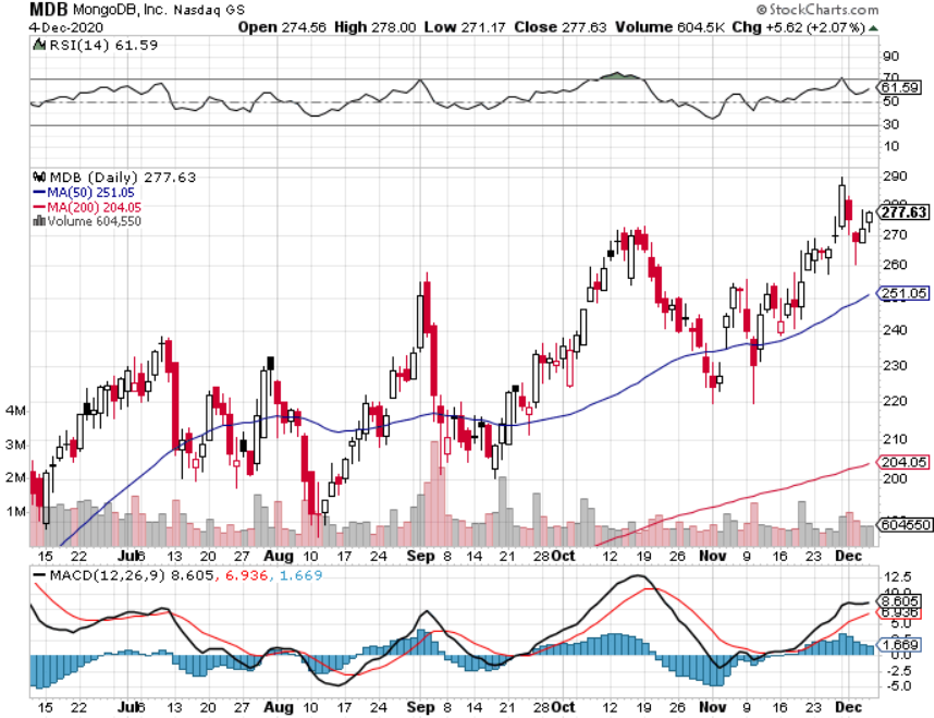
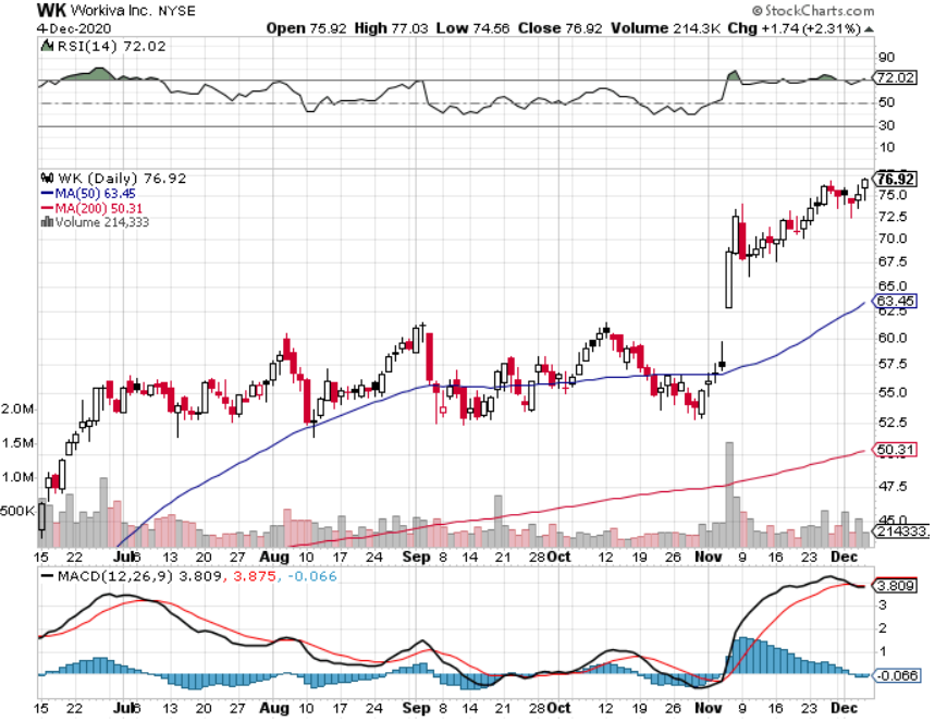
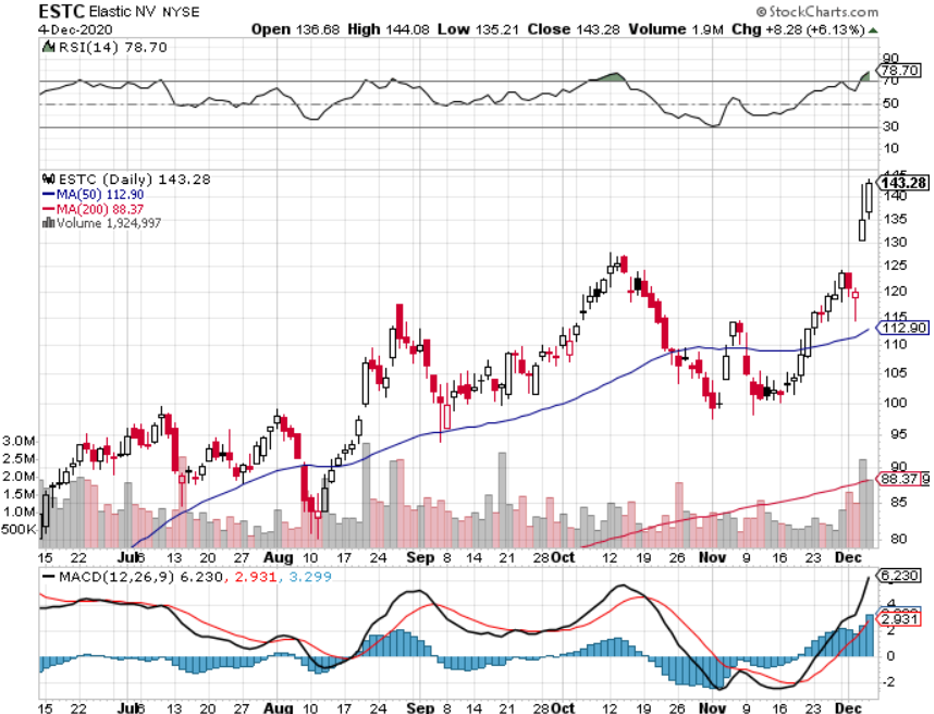
Legal Disclaimer
There is a very high degree of risk involved in trading. Past results are not indicative of future returns. MadHedgeFundTrader.com and all individuals affiliated with this site assume no responsibilities for your trading and investment results. The indicators, strategies, columns, articles and all other features are for educational purposes only and should not be construed as investment advice. Information for futures trading observations are obtained from sources believed to be reliable, but we do not warrant its completeness or accuracy, or warrant any results from the use of the information. Your use of the trading observations is entirely at your own risk and it is your sole responsibility to evaluate the accuracy, completeness and usefulness of the information. You must assess the risk of any trade with your broker and make your own independent decisions regarding any securities mentioned herein. Affiliates of MadHedgeFundTrader.com may have a position or effect transactions in the securities described herein (or options thereon) and/or otherwise employ trading strategies that may be consistent or inconsistent with the provided strategies.
This site uses cookies. By continuing to browse the site, you are agreeing to our use of cookies.
OKLearn moreWe may request cookies to be set on your device. We use cookies to let us know when you visit our websites, how you interact with us, to enrich your user experience, and to customize your relationship with our website.
Click on the different category headings to find out more. You can also change some of your preferences. Note that blocking some types of cookies may impact your experience on our websites and the services we are able to offer.
These cookies are strictly necessary to provide you with services available through our website and to use some of its features.
Because these cookies are strictly necessary to deliver the website, refuseing them will have impact how our site functions. You always can block or delete cookies by changing your browser settings and force blocking all cookies on this website. But this will always prompt you to accept/refuse cookies when revisiting our site.
We fully respect if you want to refuse cookies but to avoid asking you again and again kindly allow us to store a cookie for that. You are free to opt out any time or opt in for other cookies to get a better experience. If you refuse cookies we will remove all set cookies in our domain.
We provide you with a list of stored cookies on your computer in our domain so you can check what we stored. Due to security reasons we are not able to show or modify cookies from other domains. You can check these in your browser security settings.
These cookies collect information that is used either in aggregate form to help us understand how our website is being used or how effective our marketing campaigns are, or to help us customize our website and application for you in order to enhance your experience.
If you do not want that we track your visist to our site you can disable tracking in your browser here:
We also use different external services like Google Webfonts, Google Maps, and external Video providers. Since these providers may collect personal data like your IP address we allow you to block them here. Please be aware that this might heavily reduce the functionality and appearance of our site. Changes will take effect once you reload the page.
Google Webfont Settings:
Google Map Settings:
Vimeo and Youtube video embeds:
